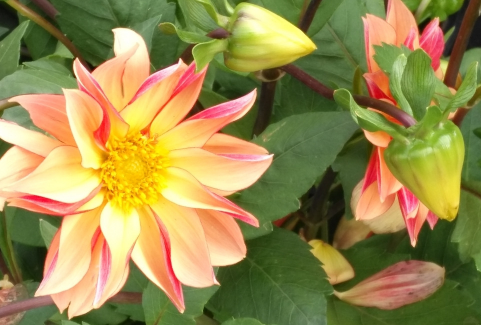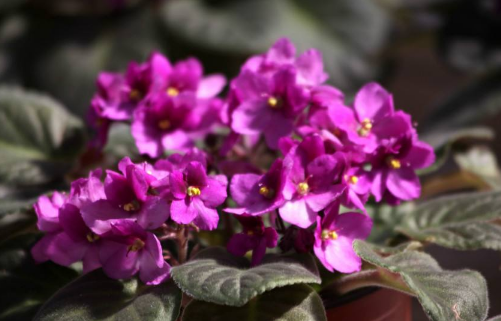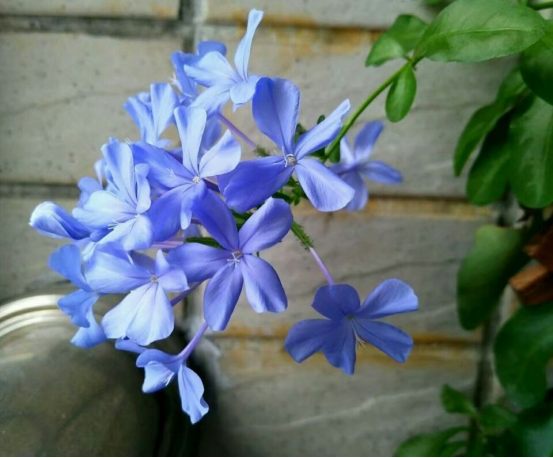Prevention and control of diseases of dahlia
Powdery mildew
Symptoms: powdery mildew mainly affects the leaves, pedicels and buds of the plant. When the plant is sick, there is a round white powder layer on the plant, which causes the leaves to twist and wilt.
Prevention and control methods: powdery mildew is mostly born in autumn, and some diluted solution of anti-mycin can be sprayed when the disease occurs, which has a good control effect.

Brown spot disease
Symptoms: Brown spot is mainly infected leaves, with yellow spots, gradually expanding, and will produce black mildew on the surface of the leaves.
Control methods: the general plant disease will be in June to August, Bordeaux solution or chlorothalonil solution can be used for treatment.
The above is the treatment of Xiaoli after flowering. I hope the Xiaoli you take care of will be healthier and more beautiful.
Xiaoli flower diseases and insect pests how to control Xiaoli gorgeous flowers and colors, burning people, in a variety of states. With a long florescence, it is one of the most famous flowers in the world. The plant type is short, the flowers are colorful, and the full bloom coincides with the National Day, which is most suitable for family potted plants. How to control the diseases and insect pests of Xiaoli in the process of cultivation? Xiaoli sex like sunshine, appropriate mild climate, growth temperature of 10: 25 ℃ is better, both afraid of heat, and not cold-resistant, temperature 0 ℃ tuber root frozen, summer high temperature and rainy area plant growth stagnation, in semi-dormancy state, not resistant to drought, more afraid of waterlogging, avoid heavy clay, root rot after being soaked. Powdery mildew is harmful to leaves, pedicels and buds, which appears nearly round white powder layer spots, expands into powdery powder layer mottled, leaves twisted and withered. The bacteria spend the winter in the diseased body and spread by airflow, and the disease is serious from September to October. At the initial stage of the disease, 2% antimycin 120 aqueous agent 100% 200 times or 40% polysulfide colloid suspension 800 times can be sprayed once in 10 days for 2 times in a row. After infected with brown spot, the leaves initially appeared yellowish dots, expanded and sunken, and finally formed near round central gray-white, edge dark brown white disease spots, with wheel lines, 1-5 mm in diameter, and light black mildew on the surface. The pathogen overwinters in the remains of diseased leaves, and the disease is serious from June to August, which can be controlled 600 times with 1% Bordeaux solution or 75% chlorothalonil. Virus disease shows mosaic, chlorosis, dwarfing and other symptoms. The viruses are Xiaoli mosaic virus, cucumber mosaic virus, tomato spot wilt virus, tobacco line virus, leafhopper and aphids. Non-toxic breeding materials can be used to control virus-transmitting insects. Xiaoli flower borer moth larva yellowish or light red, the annual occurrence of 2-3 generations, larvae for the damage period of 6-8 months, can spray 50% fenitrothion 1000 times, such as moth-eaten human stem, can be injected with omethoate 100 times 200 times. Diseases and insect pests of Xiaoli flower and its control
Diseases of Xiaoli Flower and its Control
Powdery mildew
Powdery mildew is a common disease of Xiaoli, which mainly harms the leaves, pedicels and buds of the plant. When powdery mildew occurs in Xiaoli, pathological changes will appear on the plant, which is a round powdery spot layer, causing the leaves to twist and wither.
The occurrence of powdery mildew in Xiaoli is mostly in September or October. When the disease occurs, you can spray some agents, such as the diluted solution of antimycin or the diluted solution of polysulfide gel suspension, for several times in a row, which will have a therapeutic effect.
Brown spot disease
Brown spot is also a common disease of Xiaoli. When it occurs, it mainly infects the leaves, has yellow spots, and gradually expands, and produces black mildew on the surface of the leaves.
Xiaoli has brown spot, which is usually serious from June to August, and can be treated with Bordeaux solution or chlorothalonil solution.
Viral disease
Virus disease is also a common disease of Xiaoli flower, which is mainly characterized by flower and leaf chlorosis, plant dwarfing and so on.
Xiaoli flower virus disease is mainly infected with some viruses and pathological changes. When raising Xiaoli flowers, cry and choose some pest-free planting materials to prevent insect pests.
Insect pests of Xiaoli flower and its control
Borer moth larva
The common pest of Xiaoli is the borer moth larva, which is yellowish or reddish, and the damage period is mainly from June to August.
Prevention and cure method
When Xiaoli is attacked by borer moth larvae, it can be treated by spraying some insecticides that kill borers. You can also inject omethoate.
- Prev

Sowing and Propagation of Corydalis
The sowing time can be spring or autumn, and the greenhouse cultivation will have a higher germination rate from September to October. Soil Corydalis seeds are very small, sowing basin soil should also be fine, after sowing do not need to cover the soil, flattening on the line. The optimum temperature for the growth of Corydalis is about 1826 ℃.
- Next

The culture method of Lanhuadan:
1. Blue snowflakes are plants that like light very much and can only blossom in long sunshine. As long as adequate water supply is ensured, there is no problem even in the midsummer sun exposure. It should be noted that when the light is insufficient, the number of flowers will be significantly reduced, and the branches will become softer and softer.
Related
- Fuxing push coffee new agricultural production and marketing class: lack of small-scale processing plants
- Jujube rice field leisure farm deep ploughing Yilan for five years to create a space for organic food and play
- Nongyu Farm-A trial of organic papaya for brave women with advanced technology
- Four points for attention in the prevention and control of diseases and insect pests of edible fungi
- How to add nutrient solution to Edible Fungi
- Is there any good way to control edible fungus mites?
- Open Inoculation Technology of Edible Fungi
- Is there any clever way to use fertilizer for edible fungus in winter?
- What agents are used to kill the pathogens of edible fungi in the mushroom shed?
- Rapid drying of Edible Fungi

